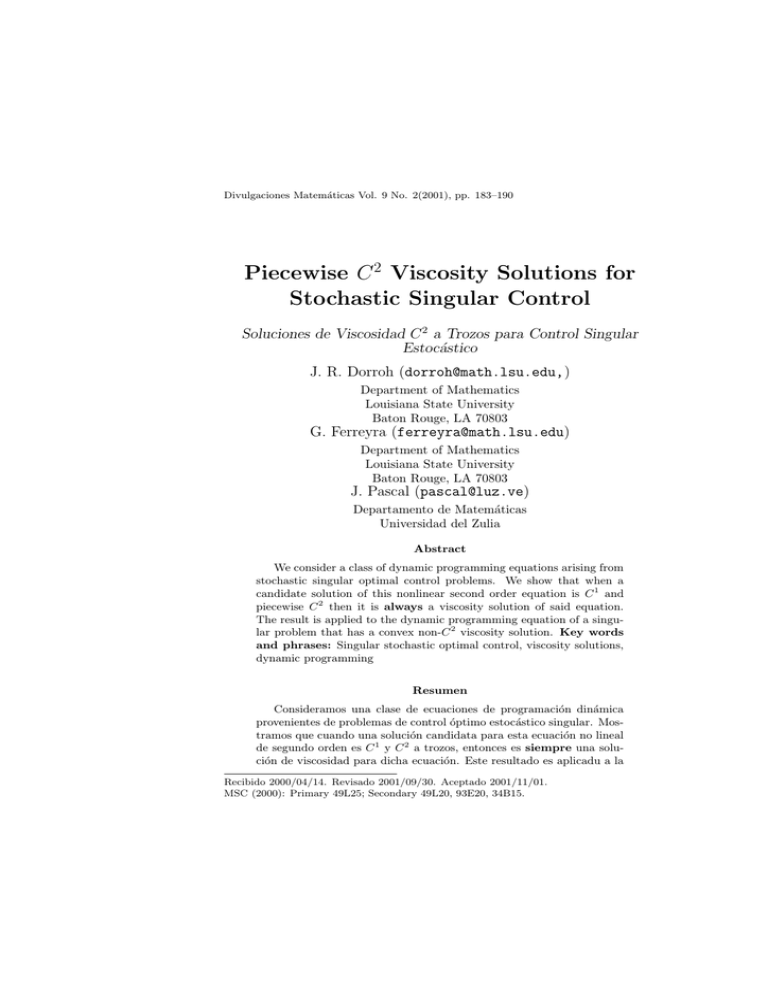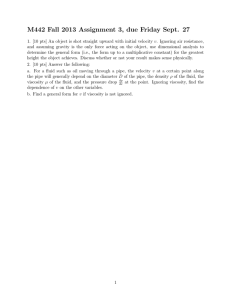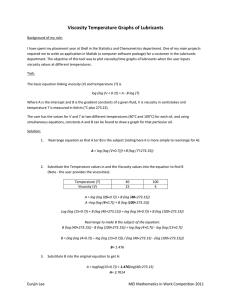C Viscosity Solutions for Stochastic Singular Control 2
advertisement

Divulgaciones Matemáticas Vol. 9 No. 2(2001), pp. 183–190
Piecewise C 2 Viscosity Solutions for
Stochastic Singular Control
Soluciones de Viscosidad C 2 a Trozos para Control Singular
Estocástico
J. R. Dorroh (dorroh@math.lsu.edu,)
Department of Mathematics
Louisiana State University
Baton Rouge, LA 70803
G. Ferreyra (ferreyra@math.lsu.edu)
Department of Mathematics
Louisiana State University
Baton Rouge, LA 70803
J. Pascal (pascal@luz.ve)
Departamento de Matemáticas
Universidad del Zulia
Abstract
We consider a class of dynamic programming equations arising from
stochastic singular optimal control problems. We show that when a
candidate solution of this nonlinear second order equation is C 1 and
piecewise C 2 then it is always a viscosity solution of said equation.
The result is applied to the dynamic programming equation of a singular problem that has a convex non-C 2 viscosity solution. Key words
and phrases: Singular stochastic optimal control, viscosity solutions,
dynamic programming
Resumen
Consideramos una clase de ecuaciones de programación dinámica
provenientes de problemas de control óptimo estocástico singular. Mostramos que cuando una solución candidata para esta ecuación no lineal
de segundo orden es C 1 y C 2 a trozos, entonces es siempre una solución de viscosidad para dicha ecuación. Este resultado es aplicadu a la
Recibido 2000/04/14. Revisado 2001/09/30. Aceptado 2001/11/01.
MSC (2000): Primary 49L25; Secondary 49L20, 93E20, 34B15.
184
J. R. Dorroh, G. Ferreyra and J. Pascal
ecuación de la programación dinámica. Palabras y frases clave: control óptimo estocástico singular, soluciones de viscosidad, programación
dinámica.
1
Introduction
Let Sn denote the set of all symmetric real-valued n×n-matrices. Some infinite
horizon stochastic singular optimal control problems with the control taking
values in a closed cone U ⊂ Rk lead to a dynamic programming equation of
the form
max[F 1 (x, v(x), Dv(x), D2 v(x)), F 2 (x, v(x), Dv(x))] = 0
(1)
for x ∈ O, where O, the state space of the control problem, is some nonempty
connected open subset of Rn , F 1 is a continuous real-valued function on O ×
R × Rn × Sn and F 2 is a continuous real-valued function on O × R × Rn . The
coercivity assumption that the function r → F 1 (x, u, p, r) is nonincreasing
on Sn is universal in the theory of viscosity solutions, and this assumption
is made here. In fact, it can be shown in great generality that the value
function of such control problems satisfies an equation of the form of (1) in
the viscosity sense (see [7, Chapter VIII]). Thus, (1) is a necessary condition
for the value function of the optimal control problem. The PDE (1) is called
a free boundary problem, since the crucial step in solving it is to locate the
subset B of O, called the free boundary, where there is a switch between the
conditions
F 1 (·, v, Dv, D2 v) = 0, F 2 (·, v, Dv) ≤ 0,
(2)
and
F 1 (·, v, Dv, D2 v) ≤ 0,
F 2 (·, v, Dv) = 0.
(3)
It is well known, and trivial to prove, that a C 2 solution of (1) is a viscosity
solution of (1). Also known is the fact that a weaker notion of solution of (1)
where the solution is only assumed to have a locally Lipschitz derivative, and
(1) is satisfied a.e., is in general not sufficient to provide a viscosity solution
of (1). Our theorem is a result which sits in between these two facts. In fact,
we show that naturally arising C 1 , piecewise-C 2 solutions of (1) are in fact
viscosity solutions of (1).
A route commonly followed to explicitly solve an optimal control problem
involves the following three steps.
Divulgaciones Matemáticas Vol. 9 No. 2(2001), pp. 183–190
Piecewise C 2 Viscosity Solutions for Stochastic Singular Control
185
(1.a) Piece together a candidate solution of the dynamic programming equation using differential equations methods. This gives a candidate value
function.
(1.b) Identify a candidate optimal feedback control strategy.
(1.c) Prove a verification theorem asserting that the candidates in (1.a) and
(1.b) are actually the optimal control and the value function, respectively, for the control problem.
An alternate route involves the following steps.
(2.a) Prove that the dynamic programming equation has a unique solution in
the viscosity sense.
(2.b) Piece together a candidate solution of the dynamic programming equation using differential equations methods.
(2.c) Prove that this candidate solution is indeed a viscosity solution of the
dynamic programming equation.
The advantage of this second route is that it produces, by methods of analysis,
the explicit solution of the dynamic programming equation and avoids, in the
case of stochastic control problems, the difficult probabilistic steps ([1, pp.
53-54]) of having to identify the optimal feedback control and optimal trajectories, and having to evaluate the costs of these in order to prove a verification
theorem. The drawback of this method is that without the probabilistic step,
only a formal understanding of the optimal control policy and the optimal
process is achieved.
If the candidate solution obtained by differential equations methods as in
step (2.b) is C 2 , then it is automatically a viscosity solution of (1). Such
is the case for the well-known monotone follower problem ([1]), which has
a C 2 value function. Our theorem shows that after completing step (2.b),
the naturally arising piecewise-C 2 (but perhaps not C 2 ) solutions of (1) are
likewise automatically viscosity solutions. That is, our theorem renders step
(2.c) automatic. A result for multidimensional deterministic singular control
problems related to ours appears in [6]. That result is based on a characterization of viscosity solutions across surfaces of nonsmoothness discovered by
Crandall and Lions ([4]) for deterministic problems.
In section 3 we present a one-dimensional example for which the dynamic
programming equation has more than one viscosity solution, one of which
is C 1 , convex, piecewise-C 2 , but not C 2 . The proof that such a solution
Divulgaciones Matemáticas Vol. 9 No. 2(2001), pp. 183–190
186
J. R. Dorroh, G. Ferreyra and J. Pascal
of the dynamic programming equation is a viscosity solution follows from
our main theorem. The fact that this solution is the value function of the
posed stochastic control problem follows easily from a verification theorem.
As we have said, viscosity solutions of the dynamic programming equation
of this example are not unique. Therefore, what is needed is the discovery
of an appropiate class of viscosity solutions for which there is a uniqueness
theorem. Unfortunately, due to the quadratic growth of the value function it
is not clear to the authors if there is a uniqueness theorem in the viscosity
sense (see step (2.a)) that applies to this problem. Recent work on uniqueness
of viscosity solutions for quadratically growing value functions appear in [2]
and [3] but do not apply to this example. Thus, step (2.a) remains open for
this example.
2
Main result
Let’s recall the definition of viscosity solution (see [7, p. 66]). A continuous
function v on an open set O ⊂ R is a viscosity subsolution of (1) if for each
x0 ∈ O
max[F 1 (x0 , v(x0 ), Dφ(x0 ), D2 φ(x0 )), F 2 (x0 , v(x0 ), Dφ(x0 ))] ≤ 0,
for all test functions φ ∈ C 2 (O) such that v(x0 ) = φ(x0 ), and v − φ attains a
local maximum at x0 .
A continuous function v on an open set O ⊂ R is a viscosity supersolution
of (1) if for each x0 ∈ O
max[F 1 (x0 , v(x0 ), Dφ(x0 ), D2 φ(x0 )), F 2 (x0 , v(x0 ), Dφ(x0 ))] ≥ 0,
(4)
for all test functions φ ∈ C 2 (O) such that v(x0 ) = φ(x0 ), and v − φ attains a
local minimum at x0 .
Finally, v is a viscosity solution if it is both a viscosity subsolution and a
viscosity supersolution.
Theorem 1. Assume that v1 and v2 are C 2 on O, and that
F 1 (·, v1 , Dv1 , D2 v1 ) = 0, F 2 (·, v2 , Dv2 ) = 0
on O. Further assume that O has a decomposition O = O1 ∪ O2 ∪ B, where
O1 and O2 are nonempty disjoint open sets with B ⊂ Ō1 ∩ Ō2 , and that
F 1 (·, v2 , Dv2 , D2 v2 ) ≤ 0 on O2 ,
F 2 (·, v1 , Dv1 ) ≤ 0 on O1 .
Divulgaciones Matemáticas Vol. 9 No. 2(2001), pp. 183–190
Piecewise C 2 Viscosity Solutions for Stochastic Singular Control
187
Further assume that for all φ ∈ C 2 (O) such that v−φ attains a local maximum
at a,with v(a) = φ(a), there is a sequence {xn } ⊂ O1 such that xn → a as
n → ∞, and D2 v1 (xn ) ≤ D2 φ(xn ).
If v1 = v2 and Dv1 = Dv2 on B, then the C 1 function v that is equal to
v1 on O1 ∪ B and v2 on O2 ∪ B is a viscosity solution of (1) on O.
Proof. Since v is a classical solution off B, v is a viscosity solution off B. Let
a ∈ B. Let φ ∈ C 2 (O) be such that v − φ attains a local maximum at a, with
v(a) = φ(a). Then Dv(a) = Dφ(a) and
F 2 (a, φ(a), Dφ(a)) = F 2 (a, v2 (a), Dv2 (a)) = 0.
Therefore, to show that v is a viscosity subsolution of (1) at x0 = a we only
need to show that F 1 (a, φ(a), Dφ(a), D2 φ(a)) ≤ 0. Since v − φ has a local
maximum at a and since v = v1 on O1 , then there is a sequence {xn } ⊂ O1
such that xn → a as n → ∞, and D2 v1 (xn ) ≤ D2 φ(xn ). Therefore, by
continuity and the coercivity assumption, we have
F 1 (a, φ(a), Dφ(a), D2 φ(a)) = F 1 (a, v1 (a), Dv1 (a), D2 φ(a))
=
≤
lim F 1 (xn , v1 (xn ), v1 (xn ), D2 φ(xn ))
n→∞
lim F 1 (xn , v1 (xn ), Dv1 (xn ), D2 v1 (xn )) = 0.
n→∞
The proof that v is a viscosity supersolution of (1) is trivial. In fact, let
φ ∈ C 2 (O) be such that v(a) = φ(a), and v − φ attains a local minimum
at a. Then Dv(a) = Dφ(a), so F 2 (a, v(a), Dφ(a)) = F 2 (a, v(a), Dv(a)) = 0.
Therefore, (4) holds at x0 = a.
3
Example
Consider the dynamic programming equation
max[F 1 (x, v(x), v 0 (x), v 00 (x)), F 2 (x, v(x), v 0 (x))] = 0
for all x ∈ R, where
F1
=
F2
=
1
v(x) − (x − K)2 − bxv 0 (x) − ²2 x2 v 00 (x),
2
−v 0 (x) − 1,
Divulgaciones Matemáticas Vol. 9 No. 2(2001), pp. 183–190
(5)
188
J. R. Dorroh, G. Ferreyra and J. Pascal
with given parameters b < 0, K and a small enough ² > 0. The equation (5) is satisfied in the viscosity sense (see [9]) by the value function v(x)
which is the infimum over all progressively measurable control pairs (ξ(·), u(·))
such
R ∞that ξ(·) is nondecreasing, real valued, left continuous with ξ(0) = 0,
E| 0 u(s)dξ(s)|m < ∞, for m = 1, 2, ..., and u is nonnegative of the costs
Z ∞
J ξ,u (x) = E x
e−t [(x(t) − K)2 dt + u(t) dξ(t)].
(6)
0
Here E x denotes the conditional expectation given that x(0) = x, and the one
dimensional state x(t) satisfies the stochastic differential equation
dx(t) = bx(t) dt + u(t) dξ(t) + ²x(t)dW (t),
(7)
with the usual hypotheses on the Brownian process W (t). This is a stochastic
singular optimal control problem. More details on this problem appear in [9].
Let K = (1 − b)/2 > 0, and A = (1 − ²2 − 2b)−1 > 0. Define
V1 (x) = Ax2 − x + K 2 ,
(8)
V2 (x) = K 2 − x,
(
V2 (x), x ≤ 0,
V3 (x) =
V1 (x), x ≥ 0.
(9)
(10)
Next, define the feedback control which is zero for x ≥ 0 and impulsive,
producing a jump to x = 0 at t = 0+ , for x < 0 as
(
−x, t = 0, x < 0,
∗
u (t, x) =
(11)
0,
otherwise,
t = 0, x < 0,
0,
∗
ξ (t, x) = 1,
t = 0+ , x < 0,
1 + t, otherwise.
Proposition 1.
(12)
1. V2 is C ∞ in R, and it is a classical solution of (5).
2. V3 is not C 2 at x = 0. V3 is nonnegative on R, but V2 is not.
3. V2 and V3 are convex viscosity solutions of (5).
4. V3 is the value function and (ξ ∗ (·, x), u∗ (·, x)) is the optimal feedback
control for (6)-(7).
Divulgaciones Matemáticas Vol. 9 No. 2(2001), pp. 183–190
Piecewise C 2 Viscosity Solutions for Stochastic Singular Control
189
Proof. It is trivial to verify the convexity and stated continuous differentiability properties of V2 and V3 . Also, the statements on the signs of V2 and V3
are trivial. It also trivial to verify that V2 satisfies (5). To conclude the proof
of (3), apply Theorem 1 to V3 once it has been verified that V1 and V2 satisfy
F 1 (·, V1 , DV1 , D2 V1 ) = 0, F 2 (·, V2 , DV2 ) = 0
on R, and that
F 1 (·, V2 , DV2 , D2 V2 ) ≤ 0, x < 0;
F 2 (·, V1 , DV1 ) ≤ 0, x > 0.
The proof of (4) involves a verification theorem ([7]). If x ≥ 0 then the solution
of (7) corresponding to (u∗ , ξ ∗ ) is
x∗ (t) = x exp[(b − ²2 /2)t − ²W (t)].
Then it is easy to check that the cost J ξ
∗
,u∗
(x) produces the function V3 .
Remark: The above proposition implies that in order to obtain a uniqueness theorem for viscosity solutions of (5) one has to keep in mind that the
desirable solution must be positive. This example also shows that the principle of smooth fit can fail even for convex problems, cf. [7, below Theorem
4.2 in Chapter VIII]. This unusual feature of the value function is due to the
fact that the diffusion (7) is degenerate at x = 0 and that is precisely where
the free boundary lies.
Another example where our theorem applies is provided by the non-C 2
value function found by Lehoczky and Shreve in [8, Thm. 6.1.b].
References
[1] Beneš, V. E., Shepp, L. A. and Witsenhausen, H. S., Some solvable
stochastic control problems, Stochastics 4(1980)39-83.
[2] Bardi, M. and Da Lio, F., On the Bellman equation for some unbounded control problems, Nonlinear Differential Equations and Applications 4(1997)491-510.
[3] Da Lio, F., On the Bellman equation for infinite horizon problems with
unbounded cost functionals, preprint.
[4] Crandall, M. G. and Lions, P. L., Viscosity solutions of HamiltonJacobi equations, Trans. AMS 277(1983)1-42.
Divulgaciones Matemáticas Vol. 9 No. 2(2001), pp. 183–190
190
J. R. Dorroh, G. Ferreyra and J. Pascal
[5] Crandall, M. G. Ishii, H. and Lions, P. L., User’s guide to viscosity solutions of second order partial differential equations, Bull. AMS
27(1992)1-67.
[6] Dorroh, J. R. and Ferreyra, G. S., Piecewise C 1 viscosity solutions
of some Bellman equations, Communications in Applied and Nonlinear
Analysis 4 (1997) 63-65.
[7] Fleming, W. H. and Soner, H. M., Controlled Markov Processes and
Viscosity Solutions, Appl. Math., vol 25, Springer-Verlag, New York,
1993.
[8] Lehoczky, J. P. and Shreve, S. E., Absolutely continuous and singular stochastic control, Stochastics 17 (1997) 91-109.
[9] Pascal, J., Ph. D. Thesis.
Divulgaciones Matemáticas Vol. 9 No. 2(2001), pp. 183–190




